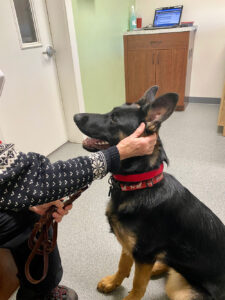By Fran Jewell

Many of you know that I train a lot of service dogs for various careers, such as guiding, mobility, diabetic alert, and hearing assistance. When working with dogs for these difficult service activities, there are basically two parts to the training. The first is public access, where the dog learns perfect manners, where to place himself, how to greet or not greet people, and how to be totally discreet so as not to bother customers in a public situation, and maintaining full attention to his handler. The second part is learning the tasks that mitigate the handler’s disabilities. Yes, the handler must have a disability that the dog is specifically trained to help handle. Emotional support or pet therapy dogs are NOT service animals.
In working with a service dog, the first requirement is to have a dog that can handle high-stress situations without fault. Even seeing loose dogs can distract a service dog, but the service dog must learn to ignore those distractions and have a natural propensity to be uninterested.
One of the things I have learned over the years that can help the service dog cope with these distractions, especially in training, is a very simple technique of touching the dog.
This applies not only to service dogs, that we actually teach to cope with stress to enhance their natural abilities, it can be applied to pet dogs on walks, or even when someone comes to visit, depending on what the stressor is for each individual dog.
I did a webinar for the National Association of Dog Obedience Instructors (NADOI) called “Stress and the Service Dog” that identified the many different ways of teaching an already solid dog how to handle daily stressors of the highly unusual public. And let’s face it, the public can be HIGHLY unusual, from running and screaming children, to cars that backfire, to folks riding on a bus filled with skis and helmets!
What I find is that many of these techniques to calm a service dog are also great for the beloved pet dog. There are many techniques taught by skilled practitioners in Reiki, Tellington TTouch Training, Healing Touch, canine massage and even canine yoga that can help. There is a plethora of homeopathic remedies, essential oils, and flower essences that can also help.
One of the simplest tools is one that comes with you on every walk, every place you go, that most people have no idea even exists. It is a simple ear massage.
First, you must learn to SEE the potential stressor for your dog. Is it a car or a pushy person? Could it be seeing another dog?
Then you must also recognize IF your dog is stressed. Blinking its eyes fast, yawning, hiding, lip licking, darting eyes, ears back, scratching, a closed mouth, hackling, sweaty paw pads, tight muscles, and even dandruff can be some of the ways your dog is letting you know he doesn’t want to be in the situation, and that he is VERY uncomfortable.
Practicing is always good before a situation happens. With the ear massage, simply hold your dog’s head in your hands, if he will let you, or reach from behind his ears. Then place your hand at the base of his ears closest to the center of his head. Your forefinger should be on one side of the ear at the base, and your thumb on the other side of the ears. Gently massage and watch your dog’s eyes soften and his neck relax!
I have yet to see this not work in a stressful situation. If you practice enough at home, your dog will know what is coming and look forward to it.
Relaxation can be incredibly difficult for dogs in many situations; however, if you arm yourself with many different tools to help reduce stress instead of pulling on a leash or yelling to stop a stress-related behavior, you and your dog can become a trusted team in the face of unknown or known difficult situations.
Fran Jewell is an IAABC Certified Dog Behavior Consultant, NADOI Certified Instructor and the owner of Positive Puppy Dog Training, LLC in Sun Valley. For more information, visit positivepuppy.com or call 208-578-1565.


